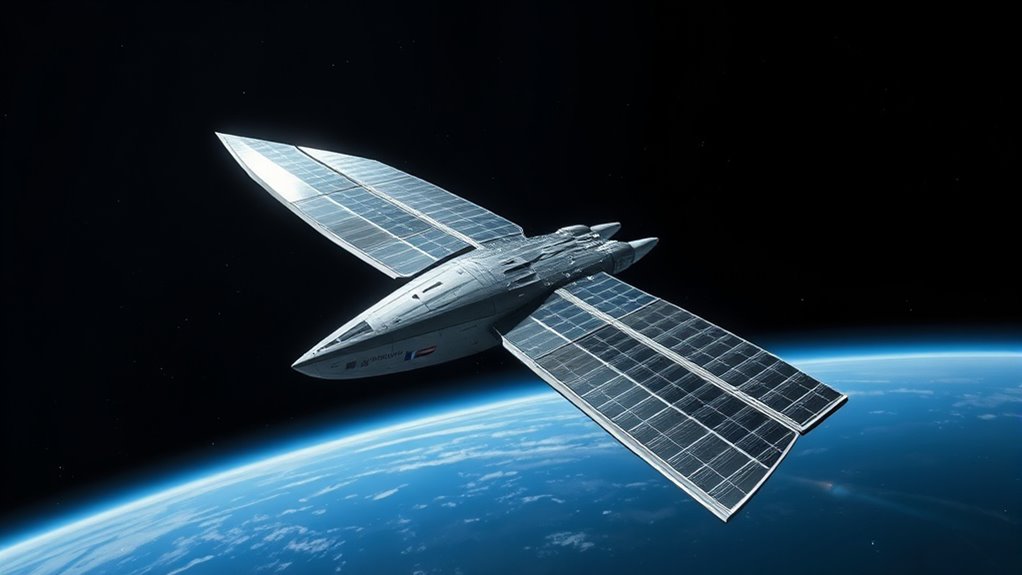Solar sails use sunlight to propel cargo ships in space, offering a fuel-free and sustainable way to move goods across the solar system. They capture photon momentum, which provides continuous thrust without needing heavy fuel tanks, allowing for larger cargo loads and longer missions. Advances in materials, like ultra-thin, reflective films, boost efficiency and durability against space hazards. Exploring these innovations reveals how solar sails could revolutionize space freight, enabling faster, greener transport in the future.
Key Takeaways
- Solar sails use sunlight to generate continuous propulsion without fuel, ideal for freight cargo in space.
- Optimized materials with high reflectivity and durability enhance sail efficiency and lifespan for cargo missions.
- Lightweight, large-area sails enable larger cargo capacities and longer interplanetary travel distances.
- Advanced nanomaterials and coatings improve sail resilience against space radiation and micrometeoroid damage.
- Innovations in manufacturing and testing ensure reliable deployment and maneuverability of solar sail freight ships.

Solar sails offer an innovative solution for cargo transportation in space, harnessing sunlight to propel spacecraft without fuel. This technology taps into the momentum of photons from the sun, providing a continuous and sustainable source of propulsion. Since solar sails rely on light rather than traditional fuel, they eliminate the need for massive fuel tanks and reduce overall spacecraft weight. This advantage allows for larger cargo capacities or extended missions, making solar sails an attractive option for freight ships traveling between planets or across space stations.
Solar sails enable fuel-free space cargo transport by harnessing sunlight’s continuous, sustainable photon momentum.
When considering solar sails, you need to pay close attention to propulsion efficiency. The efficiency depends on how well the sail captures and converts sunlight into thrust. A highly efficient sail maximizes the momentum transfer from photons, which means you get more acceleration for less surface area. To improve propulsion efficiency, engineers focus on optimizing the sail’s shape, size, and orientation. The sail must be lightweight yet capable of reflecting as much sunlight as possible. This requires advanced materials that can withstand harsh space conditions, including radiation and temperature fluctuations. The better the material’s durability, the longer the sail can operate without degradation, ensuring consistent thrust over time.
Material durability is critical for the success of solar sails. Space environments expose materials to intense radiation, micrometeoroids, and extreme temperatures. If the sail’s material isn’t durable enough, it can develop tears or lose reflectivity, reducing propulsion efficiency and risking mission failure. To combat this, engineers select or develop specialized materials, such as ultra-thin films coated with reflective substances, that resist radiation damage and mechanical wear. These materials must also be lightweight to maintain the sail’s overall efficiency but strong enough to endure the rigors of space travel. Advances in nanomaterials and polymer coatings are making sails more resilient, which extends their operational lifespan and reduces maintenance needs. Incorporating color-accurate reflective coatings can further optimize the sail’s ability to convert sunlight into thrust, enhancing overall mission success.
In addition to durability, the manufacturing process of these materials plays a crucial role in ensuring sail performance. Precision in fabricating large, uniform, and defect-free sheets influences both durability and efficiency. As you plan a cargo mission using solar sails, you’ll want to prioritize materials with proven resilience and high reflectivity, combined with a design that allows for easy deployment and maneuverability. This ensures that your spacecraft can effectively harness sunlight for propulsion, even over long distances. Conducting thorough material testing during development can help identify potential weaknesses before deployment, ensuring reliability in space. Incorporating advanced nanomaterials continues to improve the strength and longevity of sail materials, ensuring better performance in the demanding space environment. Moreover, ongoing research into innovative coating technologies is paving the way for even more durable and reflective sail materials in future missions.
Frequently Asked Questions
How Long Does a Solar Sail Take to Reach Distant Planets?
For interstellar travel, a solar sail’s journey time depends on propulsion efficiency and distance. You might expect it to take decades or even centuries to reach distant planets, as solar sails accelerate gradually using sunlight. Unlike traditional rockets, they depend on continuous acceleration, so travel times are longer but more fuel-efficient. The farther the target, the more you’ll need to rely on the sail’s ability to harness sunlight for sustained propulsion.
What Materials Are Used to Construct Durable Solar Sails?
Imagine the perfect material that can withstand harsh space conditions. You find that durable solar sails are made from lightweight fabrics, which keep them easy to handle and launch. These fabrics are coated with reflective layers that maximize sunlight capture, powering your journey across the cosmos. This combination not only guarantees resilience but also efficiency, making your voyage through space both feasible and extraordinary.
How Do Solar Sails Handle Space Debris and Micrometeoroids?
You handle space debris mitigation and micrometeoroid protection by designing solar sails with durable, puncture-resistant materials and implementing active safety measures. You can include shields or deploy protective layers that absorb impacts, and use sensors to detect potential threats early. By continuously monitoring the environment, you reduce damage risks, ensuring your sail stays functional and extends its operational life despite the hazards posed by space debris and micrometeoroids.
Can Solar Sails Be Used for Manned Cargo Missions?
Imagine harnessing the sun’s power for a manned cargo mission—it’s like riding a cosmic wave! You’d be relying on solar sails to propel your crew safely across the stars. With advanced life support systems, you can guarantee crew safety even during long journeys. Solar sails make it possible to reduce fuel needs dramatically, opening the door to sustainable, efficient, and awe-inspiring space freight missions that could revolutionize interplanetary logistics.
What Are the Limitations of Solar Sail Propulsion in Deep Space?
You might wonder about the limitations of solar sail propulsion in deep space. While it’s great for orbital maneuvering and long-distance travel, sail deployment can be tricky in harsh environments, and the propulsion relies on sunlight, which weakens farther from the Sun. Additionally, sail stability and controlling precise movements become more challenging, making deep space navigation slower and less flexible compared to traditional propulsion methods.
Conclusion
Imagine sailing through space on a gentle breeze of sunlight, your cargo driftin’ effortlessly across the cosmos. Solar sails make this dream a reality, offering a clean, endless power source that could revolutionize space freight. As you witness this new era of exploration, remember: it’s like harnessing the universe’s own heartbeat to carry humanity’s hopes and goods beyond the stars, opening doors to a future where the sky is no longer the limit.









